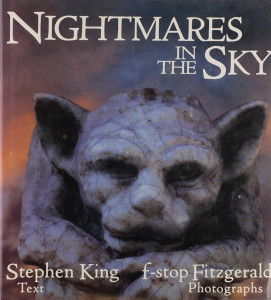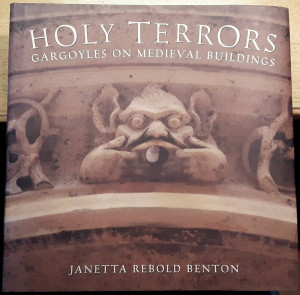 In writing my review of In The Shadow of the Gargoyle anthology, I should have made reference to Nightmares in the Sky and Holy Terrors: Gargoyles on Medieval Buildings. I’ll amend that error with a separate review of these two books.
In writing my review of In The Shadow of the Gargoyle anthology, I should have made reference to Nightmares in the Sky and Holy Terrors: Gargoyles on Medieval Buildings. I’ll amend that error with a separate review of these two books.
For those of you who don’t know what gargoyles are, I’m reprinting this commentary from this website dedicated to Mary, Queen of Scots:
Gargoyles were originally intended as waterspouts and drains to keep rain water from damaging the foundation of buildings. The term gargoyle, comes from the Latin gurgulio, and the Old French gargouille, not only meaning “throat” but also describing the “gurgling” sound made by water as it ran through the figure. Superstition held that gargoyles frightened away evil spirits while serving their practical function. After the lead drainpipe was introduced in the sixteenth century, gargoyles primarily served a decorative function.
Although most have grotesque features, the term gargoyle has come to include all types of images. Some gargoyles were depicted as monks, combinations of real animals and people, many of which were humorous. Unusual animal mixtures, or chimeras, did not act as rainspouts and are more properly called grotesques. They serve more as ornamentation, but are now synonymous with gargoyles.
Now that that’s out of the way, to answer the next obvious question: Yes, the writer of Nightmares in the Sky is that Stephen King. Briefly, this hardcover photograph and essay book contains photographs by f-stop Fitzgerald (the nom-de-shutter of Richard Minissali) of gargoyles from around the world with a text written by Stephen King. The hardcover is out of print but copies are still floating around for a very reasonable price. It appears this is not a Stephen King book that is sought after by collectors of his work — a pity given how interesting it is! I’ve often thought that the nonfiction output of this writer was more interesting than his fiction, and this book certainly supports that belief, as Nightmares in the Sky is one of the best works on gargoyles I’ve encountered. Just consider this passage from King in his introduction:
He takes me to the window, small, dirty, crisscrossed with old chicken wire, and points across the street to something which seems to be a monster being born not of a living creature but of a building. Seeing this obscene thing is a shock; what is worse is seeing the people passing to and fro beneath it, intent on either plotting their day’s business or their evening’s pleasure; they pass to and fro and do not look up.
None of them look up.
I hear him say it again: We don’t see them … but they see us.
King’s essay very neatly complements the photographs of Fitzgerald. This is a visually magnificent book, excellent to use as a reference for understanding what a gargoyle is. I should note that some of the creatures included in here are definitely not gargoyles, but they apparently struck the fancy of the photographer. Throughout Nightmares in the Sky, Fitzgerald, a renowned photographer, captures the true essence of these creatures. His 100 black-and-white and 24 color photographs are brilliantly done. Readers can learn many interesting facts about these creatures in the easy-to-read text. This is a book any lover of gargoyles should have in their library.
 Holy Terrors: Gargoyles on Medieval Buildings is a more traditional look at the gargoyles in their traditional medieval setting. And it’s worth looking at our review of Anthony Hayward’s The Green Men of Birmingham, as the green men are another interesting sculpture form. Both are more grounded in history than Nightmares in the Sky is. King is a good writer but he’s not a historian. Or even a decent student of history. But Janetta Rebold Benton is a professor in Art History, so her viewpoint is that of a scholar — quite knowledgeable and just the right level of passion. Her area’s Medieval Art, so gargoyles, which are quintessentially medieval in nature, are right up her mew!
Holy Terrors: Gargoyles on Medieval Buildings is a more traditional look at the gargoyles in their traditional medieval setting. And it’s worth looking at our review of Anthony Hayward’s The Green Men of Birmingham, as the green men are another interesting sculpture form. Both are more grounded in history than Nightmares in the Sky is. King is a good writer but he’s not a historian. Or even a decent student of history. But Janetta Rebold Benton is a professor in Art History, so her viewpoint is that of a scholar — quite knowledgeable and just the right level of passion. Her area’s Medieval Art, so gargoyles, which are quintessentially medieval in nature, are right up her mew!
She starts with a full overview of how gargoyles came to be — and mercifully their history is easier to document that that of the green men — and how they were constructed. Three glorious chapters follow, richly illustrated, depicting and fully describing them in all their myriad forms. In clear, almost lyrical language, Janetta Rebold Benton puts these personality-filled sculptures into their proper setting of medieval art and life. The color photos very nicely allow her to illustrate her comments. She concludes Holy Terrors with an invaluable look at where one can find gargoyles in Europe. (I wish I had had this book when I visited Paris a few decades ago!) The publisher claims this is the first book to deal with gargoyles in a readable fashion, and they may well be right!
(Abbeville Press, 1997)
(Viking Studio, 1988)
